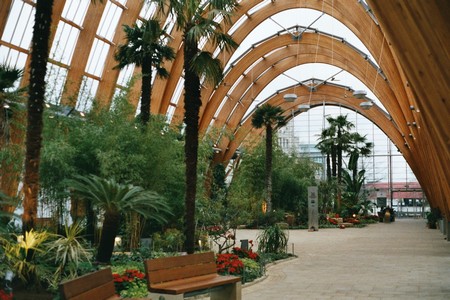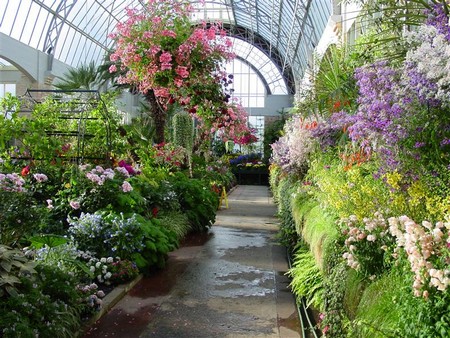Best Way to Paint a Winter Garden with Plants
Winter-flowering plants are invaluable for brightening the so-called dull season of the year. Winter-brightening shrubs and trees with colorful barks and stems look superb on their own, but when other plants are positioned around them, their season is extended and the display improved. Here are a few combinations of plants that will bring added cheer to your garden.
Associations for early winter
With the richly-colored leaves of autumn a blurred memory, color in a winter garden is always welcome. For an unusual combination of white and purple – which is especially attractive in the low and fading light of a winter afternoon – plant the deciduous tree Salixdaphnoides (violet willow) near a group of silver birches. Prune young shoots of the willow hard back in early spring to encourage the growth of colorful stems for the following winter.
Try a combination of Hamamelis mollis ‘Pallida’ (Chinese witch hazel), with pale yellow flowers faintly flushed claret-red at their centres, with a grouping of Erica carnea ‘King George’ planted in front. The rose-pink flowers ofthe erica associate well with the outstandingly beautiful flowers ofthe hamamelis, which are borne on leafless branches.
Train Jasminum nudiflorum (winter-flowering jasmine) against a north-facing wall and plant Erica carnea ‘King George’ in front.
Associations for mid-winter
Once Christmas has passed and the days begin to lengthen once more, the garden becomes a place of increasing cheer. Plant the evergreen Helleborus niger (Christmas rose), bearing saucer-shaped white flowers, with white- or pink-flowered winter-flowering ericas (Erica carnea) in front of it. Use varieties such as ‘Springwood Pink’ (rich pink), ‘Springwood White’ (white) or ‘Winter Beauty’ (rich pink).
Grow the yellow-flowered Jasminum nudiflorum (winter-flowering jasmine) on a north-facing wall with a rose-pink form ofthe evergreen shrub Camelliasasanqua in front. Plant the bulbous and purple-flowering Crocus imperati beneath Hamamelis mollis (Chinese witch hazel). It creates an attractive combination of purple and golden-yellow. This crocus naturalizes well in grass, but a large number of them are needed to create a dominant display.
Associations for late winter
With winter’s worst weather fading and spring waiting to break, this is an exciting and bright time in the garden. In some areas, however, the perfidious nature of weather slows things up, and some of these combinations of plants will appear in early spring, rather than late winter.
- The tuberous-rooted Eranthis hyemalis (winter aconite), with its lemon-yellow flowers, is ideal for planting under silver birches.
- Naturalize the bulbous Crocus chrysanthus in large drifts under silver birches.
- Plant Primula ‘Wanda’, with dark red-purple flowers, around Rhododendron x praecox, which reveals rose-purple flowers.
- Plant the bulbous, bright royal-blue Iris histrioides in front of the late winter or early spring-flowering Forsythiasuspensa, which reveals bright yellow, pendulous flowers. The forsythia is ideal for planting against a sunny wall, which encourages earlier flowering.
- For a plant combination in a woodland garden, try a white-flowered form of the bulbous Erythronium dens-canis (dog’s-tooth violet) with the deep-blue and bulbous Scilla bifolia. Plant each in dominant clumps.
The winter-flowering jasmine (Jasminum nudiflorum) offers a colorful background to other plants throughout much of winter, and none is more deserving than the well-known Rhododendron ‘Christmas Cheer’, which we are now instructed to call ‘Ima-shojo’. It has blush-pink flowers that last longer in cool, partial shade than strong sunlight, and combine perfectly with the yellow of the jasmine.
Categories
Advertisements
Recent Articles
 How to Understand Bed Sizes – A Small Guide
How to Understand Bed Sizes – A Small Guide How to Select Some Must Have Kitchen Accessories
How to Select Some Must Have Kitchen Accessories Best Way to Change a Car Tire
Best Way to Change a Car Tire Best Way to Write an Affirmation
Best Way to Write an Affirmation Best Way to Take Charge of Your Financial Life
Best Way to Take Charge of Your Financial Life Best Way to Survive a Party When You Don’t Know Anyone
Best Way to Survive a Party When You Don’t Know Anyone Best Way to Stop Self Sabotaging Yourself
Best Way to Stop Self Sabotaging Yourself Best Way to Start Journal Writing
Best Way to Start Journal Writing Best Way to Speak with a Powerful Voice
Best Way to Speak with a Powerful Voice Best Way to Simplify Your Life
Best Way to Simplify Your Life Best Way to Respond to a Put-Down
Best Way to Respond to a Put-Down Best Way to Reduce Acne Breakouts
Best Way to Reduce Acne Breakouts Best Way to Recover from Dining Disasters
Best Way to Recover from Dining Disasters Best Way to Quit Your Job Gracefully
Best Way to Quit Your Job Gracefully Best Way to Make Your Own Website
Best Way to Make Your Own Website



Leave a Reply